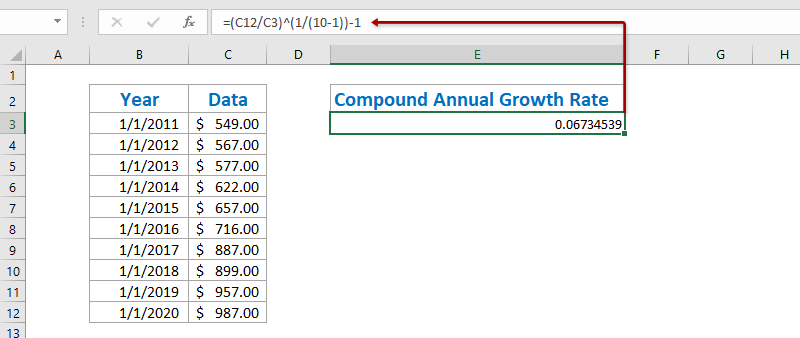¿Cómo calcular la tasa de crecimiento anual promedio/compuesta en Excel?
Este artículo trata sobre formas de calcular la Tasa de Crecimiento Anual Promedio (AAGR) y la Tasa de Crecimiento Anual Compuesta (CAGR) en Excel.
- Calcular la tasa de crecimiento anual compuesta en Excel
- Calcular la tasa de crecimiento anual compuesta con la función XIRR en Excel
- Calcular la tasa de crecimiento anual promedio en Excel
Calcular la Tasa de Crecimiento Anual Compuesta en Excel
Para calcular la Tasa de Crecimiento Anual Compuesta en Excel, hay una fórmula básica =((Valor Final/Valor Inicial)^(1/Períodos) -1. Y podemos aplicar fácilmente esta fórmula de la siguiente manera:
1. Seleccione una celda en blanco, por ejemplo, la Celda E3, ingrese la siguiente fórmula en ella y presione la tecla Enter . Ver captura de pantalla:
=(C12/C3)^(1/(10-1))-1
Nota: En la fórmula anterior, C12 es la celda con el valor final, C3 es la celda con el valor inicial, 10-1 es el período entre el valor inicial y el valor final, y puedes cambiarlos según tus necesidades.

2En algunos casos, el resultado del cálculo puede no estar formateado como un porcentaje. Mantenga seleccionado el resultado del cálculo, haga clic en el Estilo de Porcentaje botón ![]() en la Inicio pestaña para cambiar el número al formato de porcentaje, y luego cambie sus decimales haciendo clic en el Aumentar Decimal botón
en la Inicio pestaña para cambiar el número al formato de porcentaje, y luego cambie sus decimales haciendo clic en el Aumentar Decimal botón ![]() o Disminuir Decimal botón
o Disminuir Decimal botón ![]() Ver captura de pantalla:
Ver captura de pantalla:

Calcular la tasa de crecimiento anual compuesta con la función XIRR en Excel
De hecho, la función XIRR puede ayudarnos a calcular fácilmente la Tasa de Crecimiento Anual Compuesta en Excel, pero requiere que crees una nueva tabla con el valor inicial y el valor final.
1Cree una nueva tabla con el valor inicial y el valor final como se muestra en la primera captura de pantalla a continuación:
Nota: En la Celda F3 ingrese =C3, en la Celda G3 ingrese =B3, en la Celda F4 ingrese =-C12, y en la Celda G4 ingrese =B12, o puede ingresar sus datos originales directamente en esta tabla. Por cierto, debe agregar un signo menos antes del Valor Final.
2. Seleccione una celda en blanco debajo de esta tabla, ingrese la siguiente fórmula en ella y presione la tecla Enter.
=XIRR(F3:F4,G3:G4)

3Para cambiar el resultado al formato de porcentaje, seleccione la Celda con esta función XIRR, haga clic en el Estilo de Porcentaje botón ![]() en la Inicio pestaña, y luego cambie sus decimales haciendo clic en el Aumentar Decimal botón
en la Inicio pestaña, y luego cambie sus decimales haciendo clic en el Aumentar Decimal botón ![]() o Disminuir Decimal botón
o Disminuir Decimal botón ![]() Ver captura de pantalla:
Ver captura de pantalla:

Guarde rápidamente la tabla CAGR como una mini plantilla y reutilícela con un solo clic en el futuro
Debe ser muy tedioso referenciar celdas y aplicar fórmulas para calcular los promedios cada vez. Kutools para Excel proporciona una solución práctica con la utilidad AutoTexto para guardar el rango como una entrada de AutoTexto, lo que puede mantener los formatos de celda y las fórmulas en el rango. Luego podrá reutilizar este rango con solo un clic.
Calcular la Tasa de Crecimiento Anual Promedio en Excel
Para calcular la Tasa de Crecimiento Anual Promedio en Excel, normalmente tenemos que calcular las tasas de crecimiento anual de cada año con la fórmula = (Valor Final - Valor Inicial) / Valor Inicial, y luego promediar estas tasas de crecimiento anual. Puedes hacer lo siguiente:
1. Además de la tabla original, ingrese la siguiente fórmula en la Celda en blanco C3 y luego arrastre el Controlador de Relleno hasta el Rango C3:C11.
=(C4-C3)/C3
2Seleccione el Rango D4:D12, haga clic en el Estilo de Porcentaje botón ![]() en la Inicio pestaña, y luego cambie sus decimales haciendo clic en el Aumentar Decimal botón
en la Inicio pestaña, y luego cambie sus decimales haciendo clic en el Aumentar Decimal botón ![]() o Disminuir Decimal botón
o Disminuir Decimal botón ![]() Ver captura de pantalla:
Ver captura de pantalla:

3. Promedie todas las tasas de crecimiento anual ingresando la siguiente fórmula en la Celda F4 y presione la tecla Enter .
=PROMEDIO(D4:D12)

Hasta ahora, se ha calculado y mostrado la Tasa de Crecimiento Anual Promedio en la Celda C12.
Demostración: calcular la tasa de crecimiento anual promedio/compuesta en Excel
Artículos relacionados:
Las mejores herramientas de productividad para Office
Mejora tu dominio de Excel con Kutools para Excel y experimenta una eficiencia sin precedentes. Kutools para Excel ofrece más de300 funciones avanzadas para aumentar la productividad y ahorrar tiempo. Haz clic aquí para obtener la función que más necesitas...
Office Tab incorpora la interfaz de pestañas en Office y facilita mucho tu trabajo
- Habilita la edición y lectura con pestañas en Word, Excel, PowerPoint, Publisher, Access, Visio y Project.
- Abre y crea varios documentos en nuevas pestañas de la misma ventana, en lugar de hacerlo en ventanas separadas.
- ¡Aumenta tu productividad en un50% y reduce cientos de clics de ratón cada día!
Todos los complementos de Kutools. Un solo instalador
El paquete Kutools for Office agrupa complementos para Excel, Word, Outlook y PowerPoint junto con Office Tab Pro, ideal para equipos que trabajan en varias aplicaciones de Office.
- Suite todo en uno: complementos para Excel, Word, Outlook y PowerPoint + Office Tab Pro
- Un solo instalador, una licencia: configuración en minutos (compatible con MSI)
- Mejor juntos: productividad optimizada en todas las aplicaciones de Office
- Prueba completa de30 días: sin registro ni tarjeta de crédito
- La mejor relación calidad-precio: ahorra en comparación con la compra individual de complementos